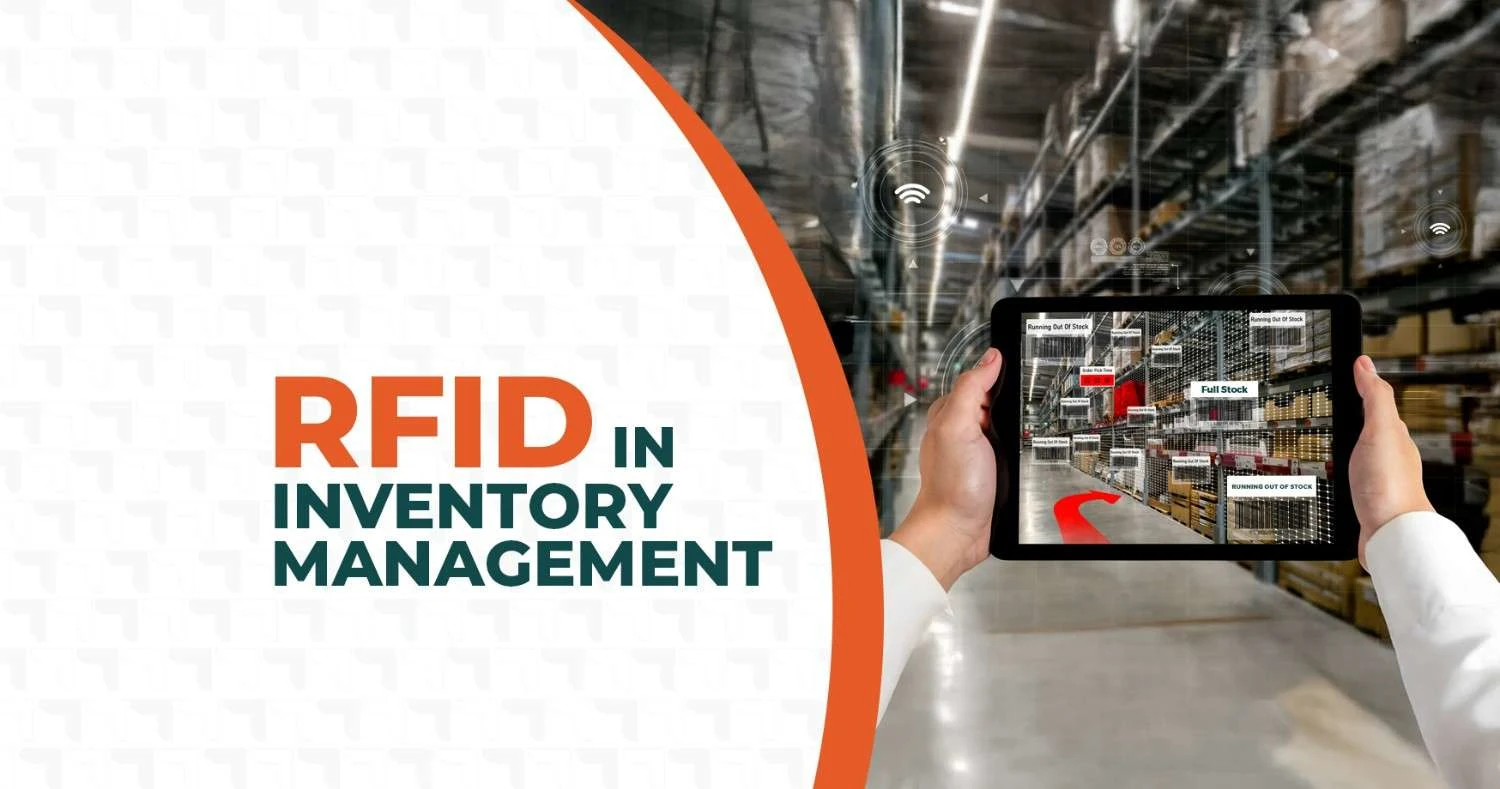
RFID in Inventory Management
Inventory management is one of the toughest challenges for any business. From knowing how much stock is available to where it sits in the supply chain, accuracy is critical. Manual counts and barcode scans provide partial visibility, but they cannot keep pace with the speed and complexity of modern operations. RFID in inventory management addresses this limitation by enabling instant, real-time product tracking without the need for line-of-sight scanning.
This guide explores how RFID works in inventory management, the benefits it delivers, practical applications across industries, key challenges to consider, and what the future holds for this technology.
What is RFID in Inventory Management?
RFID in inventory management is the practice of using radio frequency identification tags, antennas, and readers to automatically capture and update stock information across warehouses, retail shelves, and production floors. Unlike barcodes that demand manual, line-of-sight scanning, RFID tags transmit data wirelessly, allowing hundreds of items to be tracked simultaneously, even from a distance.
This capability is crucial in modern supply chains where delayed updates or inaccurate stock counts can cause stockouts, overstocking, or revenue leakage. By embedding RFID technology in inventory management, businesses gain real-time visibility, minimize human error, and optimize processes such as replenishment, audits, and demand forecasting. In short, RFID transforms inventory management from a reactive task into a proactive, data-driven operation.
You can also explore what is an inventory management system.
How RFID Works in Inventory Management?
RFID redefines how information moves through the supply chain. Instead of manual scans or delayed reports, the system creates a continuous loop of identification, capture, and visibility. Understanding its workflow reveals why it delivers such a leap in efficiency.
1. Tagging Items – An RFID tag is attached to each product, box, or pallet. This tag contains a unique digital identity that travels with the item throughout its journey in storage or transit.
2. RFID Readers/Scanners – RFID Readers positioned at important checkpoints such as dock doors, storage racks, or forklifts automatically detect tags within their range. They capture data simultaneously from multiple items without human involvement.
3. Data Transmission – The collected tag information is instantly transmitted to the central inventory platform. This stream of data synchronizes with existing systems, ensuring every movement is recorded and traceable.
4. Real-Time Updates – Managers see a live picture of stock across the warehouse or store. From inbound shipments to shelf replenishment, every activity is tracked in real time, eliminating blind spots and delays.
For example, when a shipment arrives at a retail store, RFID readers at the loading dock automatically capture all tagged items at once, eliminating the need to scan each barcode individually.
Explore How Do Barcodes Work to understand the difference in terms of usage and application touchpoints.
How to Use RFID in Inventory Management
Using RFID in inventory management is less about the physics of radio waves and more about shaping smarter business processes. Companies embed RFID into their operations to make inventory data not just accurate, but actionable.
1. Choosing What to Tag
Some businesses tag every item, while others start with pallets, cases, or high-value stock. The scope of tagging depends on goals such as reducing shrinkage, monitoring raw materials, or accelerating store replenishment.
2. Deploying RFID Infrastructure
Readers and antennas are installed where visibility matters most, such as warehouse entry points, retail shelves, or even forklifts. Placement strategy determines how well the system captures movements without slowing operations.
3. Integrating with Inventory Systems
The captured data is fed into ERP, WMS, or POS systems. This turns RFID into more than a tracking tool; it becomes a decision engine for replenishment, audits, and demand planning.
4. Operationalizing Real-Time Insights
Managers and staff put RFID data to work. They trace misplaced goods, verify shipments instantly, and act on replenishment triggers. Instead of waiting for cycle counts, stock discrepancies are resolved as they happen.
Benefits of RFID for Inventory Management
Inventory teams often deal with inaccurate counts, long audit cycles, and misplaced stock, all of which slow operations. The benefits of RFID in inventory management come from replacing guesswork with live, reliable data.
1. Accuracy and error reduction
RFID in inventory management improves data integrity by automatically capturing stock movements at every checkpoint. This reduces mis-scans and human error, ensuring that recorded inventory aligns with actual on-hand quantities across warehouses or stores.
2. Faster audits and stocktaking
RFID enables rapid cycle counts by scanning hundreds of items at once. What previously required days of manual effort can now be validated in hours, cutting audit costs and improving throughput.
3. Real-time visibility and reporting
With RFID, managers gain continuous updates on stock levels, reorder points, and movement history. This live visibility improves replenishment planning, reduces stockouts, and enhances overall supply chain responsiveness.
4. Reduced shrinkage and theft prevention
RFID creates an unbroken audit trail for every tagged item. Unauthorized removals or inventory mismatches trigger alerts, helping businesses control shrinkage, reduce pilferage, and safeguard high-value assets more effectively.
5. Cost and efficiency improvements
Although RFID requires upfront investment, it lowers long-term carrying costs by reducing safety stock, cutting labor-intensive processes, and improving inventory turns, ultimately delivering stronger return on inventory operations.
Applications of RFID in Inventory Management
RFID applications in inventory cover many areas. It is not confined to one single industry. From retail shelves to factory floors and distribution hubs, the technology helps tackle different stock management challenges with clear and measurable results.
1. Retail inventory management (real-time shelf tracking)
In retail, RFID reduces guesswork in stock visibility and enhances customer experience.
- Captures product movements from warehouse to store shelves automatically
- Feeds live stock data to systems for faster replenishment decisions
- Provides item-level visibility for promotions and seasonal assortments
- Supports omnichannel fulfillment by ensuring accurate inventory records
2. Manufacturing and production tracking (raw material monitoring)
Manufacturers use RFID to tighten control over materials and finished goods.
- Tags raw materials for accurate input recording in ERP or MES systems
- Tracks work-in-progress (WIP) across different production stages
- Links products with batch records to improve traceability and recall readiness
- Automates compliance reporting through integrated data capture
3. Healthcare and pharmaceuticals (drug traceability)
In healthcare, RFID strengthens patient safety and regulatory compliance.
- Authenticates medical supplies and reduces the risk of counterfeit drugs
- Connects tagged items with batch and expiry data in inventory systems
- Creates detailed audit trails to meet regulatory requirements
- Ensures critical stock like blood bags or implants is traceable in real time
4. Warehousing and distribution (pallet tracking, dock-to-stock visibility)
RFID streamlines inbound and outbound flows in distribution centers.
- Scans pallets automatically as they move from trucks into storage
- Updates warehouse management systems for faster dock-to-stock cycles
- Locates inventory inside large facilities with higher accuracy
- Enhances cross-docking efficiency by linking shipments with order data
You can also read about the benefits of warehouse Management System to understand the operational value of the solution.
Challenges and Considerations While Implementing RFID in Inventory Management
While RFID delivers strong results, its success depends on thoughtful execution. Businesses should be aware of a few considerations before implementiong the technology.
1. Initial Setup and Cost Considerations
RFID involves upfront spending on tags, readers, and integration tools. However, costs vary by scale, and phased pilots often help businesses build ROI before full deployment.
2. Technical Integration with WMS or ERP
To maximize value, RFID data must connect smoothly with warehouse management systems or ERP platforms. With proper configuration, businesses gain a unified and real-time view of stock movements.
3. Staff Training and Adoption
New technology requires new routines. Training ensures employees understand RFID workflows, making adoption smoother and helping teams use the system to its full potential.
4. Signal Interference and Performance Factors
RFID performance can be influenced by metals, liquids, or environmental layouts. Careful planning of antenna placement, tag selection and equipment calibration helps maintain consistent and reliable reads.
Future of RFID in Inventory Management
The role of RFID in inventory management is set to expand as it combines with IoT devices, AI-driven analytics, and cloud-based platforms. Instead of simply tracking items, RFID will power predictive inventory models, automated replenishment, and demand forecasting.
RFID Tags are becoming smaller, more durable, and capable of storing richer data, while integration with real-time dashboards gives managers instant visibility across global supply chains. As RFID connects with latest technologies, systems and predictive algorithms, businesses will move from reactive stock counts to proactive decision-making.
For large enterprises, RFID is quickly becoming a standard for end-to-end visibility. For small and mid-sized businesses, modular deployments and favorable hardware costs are making RFID an increasingly practical and scalable option.
Conclusion
RFID in inventory management makes stock control simpler and more reliable. It improves accuracy, speeds up audits, reduces losses, and saves time. For large companies, it plays an important role in supply chain automation by giving real-time visibility.
For small and mid-sized businesses, flexible RFID solutions make it easier to adopt without heavy investment. Any business that struggles with invisible stock losses, delayed replenishment, or blind spots in movement tracking can turn to RFID, making it less a choice and more a necessity for future-ready inventory processes.
Contact our experts today and learn out RFID can work in your favor, as your worflows and operational scale.
FAQ
1. What is RFID in inventory management?
RFID in inventory management uses radio frequency tags and readers to automatically track, monitor, and update stock levels, reducing manual efforts, errors, and delays in warehouses, retail, and production facilities.
2. How does RFID improve inventory accuracy?
RFID improves inventory accuracy by automatically capturing stock data without manual scanning. It reduces human error, tracks items in bulk, and provides real-time visibility, ensuring stock counts remain highly precise across warehouses, retail, and manufacturing.
3. How is RFID different from barcodes?
Barcodes require direct line-of-sight scanning of each item, while RFID tags can be read wirelessly from a distance, enabling faster bulk tracking, automated updates, and higher operational efficiency overall.
4. Which industries use RFID for inventory tracking?
Industries such as retail, manufacturing, logistics, pharmaceuticals, and healthcare use RFID for inventory tracking. It enables real-time stock control, reduces shrinkage, enhances compliance, and ensures end-to-end supply chain visibility.
5. What is the cost of implementing RFID in inventory management?
Implementation costs vary by scale, hardware, and integration needs. Enterprise-level rollouts may require significant investment, while smaller businesses can adopt RFID through limited deployments or phased implementations to control expenses.
6. Can RFID work without the internet?
Yes, RFID systems can function offline by storing data locally on readers. However, connecting to the internet or cloud platforms enables real-time visibility, remote access, and advanced analytics capabilities.
7. Is RFID suitable for small businesses?
RFID can be suitable for small businesses if applied selectively. While full-scale deployments may be costly, targeted use cases such as asset tracking or warehouse visibility can deliver strong efficiency benefits.
8. How does RFID integrate with warehouse management systems?
RFID integrates with WMS by transmitting tag data directly into the software. This ensures real-time updates, faster stock reconciliation, automated workflows, and more accurate reporting for improved warehouse performance. The RFID hardware can seamlessly connect with software systems using API and SDKs.
9. What is the future of RFID in supply chain management?
The future of RFID lies in combining it with IoT, AI, and cloud platforms. These integrations will enable predictive analytics, automated restocking, end-to-end traceability, and highly responsive supply chain ecosystems.
Share this page
Get in Touch
Ready to take your business to the next level with BCI (Bar Code India)? We're just a phone call or email away.



